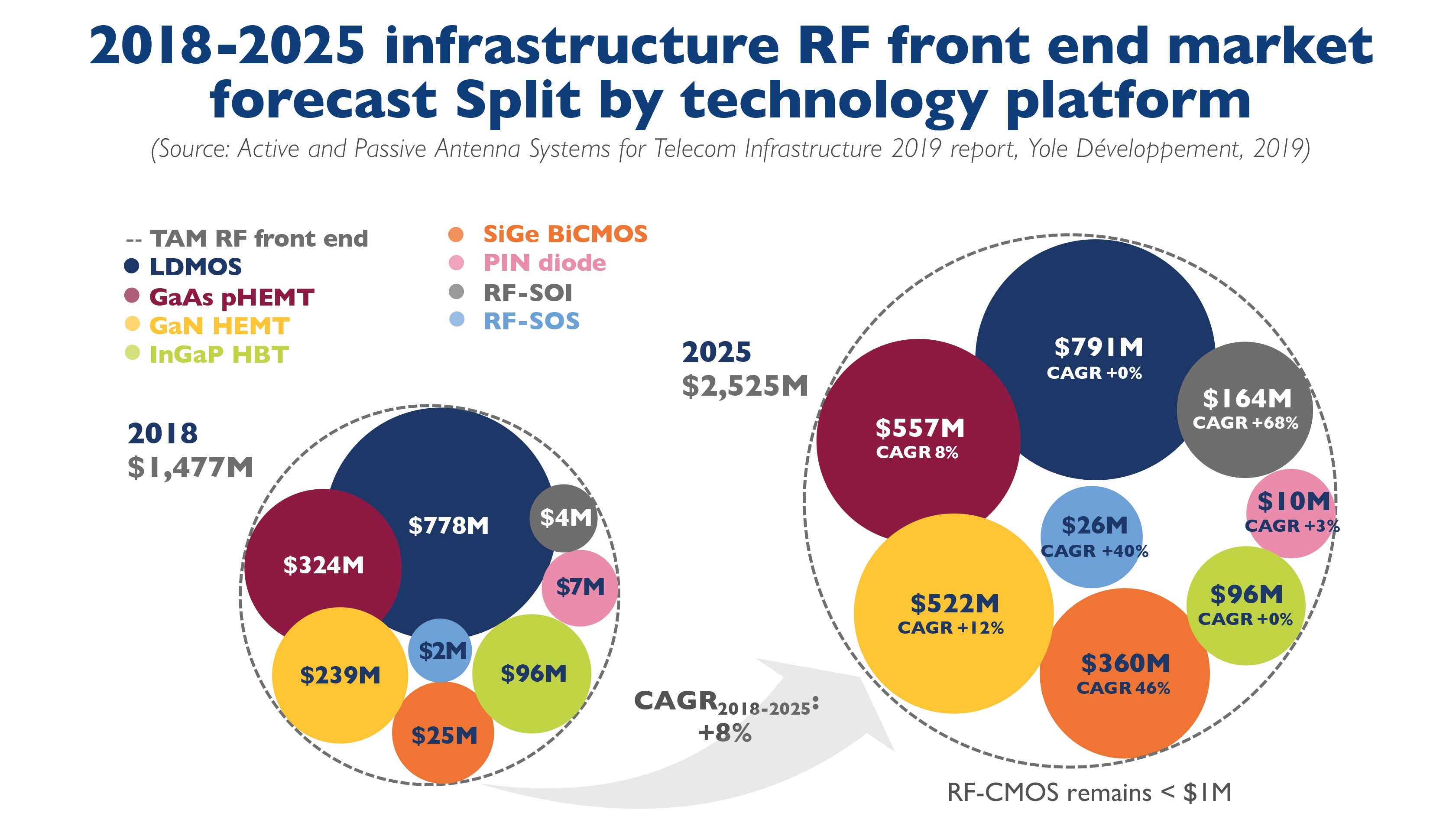Active antennas to shake up RF market, says Yole

GaAs will be a transition platform for active antenna components, predicts Yole, to be replaced by RF-SOI or SiGe
Yole and its partner company Knowmade have released two new technology reports dedicated to active and passive antennas and their ecosystems (Active and Passive Antenna Systems for Telecom Infrastructure report and Antenna for 5G and 5G-related Applications Patent Landscape report).
According to this latest research, the RF front end market for telecom infrastructure we be shaken up the new technology of active antenna systems. In 2018, Yole estimated the RF front end market was worth $1.47 billion and it thinks it will reach $2.52 billion in 2025.
5G is expected to hit the market by 2020. Yole thinks it will have strong repercussions on the current RF industry with the development of many innovative technologies such as MIMO, massive MIMO, beamforming, beam steering, carrier aggregation, and others
“It was only in 2014 that the term '5G' began appearing in patents”, explains Paul Leclaire, technology and patent analyst, Knowmade. “Since then, the number of 5G-related patent publications has seen a huge increase. At Knowmade, we see a 113 percent growth rate between 2014 and 2018. This strong acceleration is mostly pushed by the Chinese IP players, which account for more than 56 percent of the IP activity in this sector. In particular, we have noticed a large number of Chinese academic players, which is quite unusual in the telecom domain.”
Today, the IP landscape related to the development of 5G antennas is still unsettled. “With more than 75 percent of patent applications still pending, much will change in the coming years,” comments Nicolas Baron, Knowmade’s CEO. “Indeed, after an initial period of domestic patent applications, the main IP and market players including Samsung, Intel, Ericsson, and Huawei have begun extending their portfolios worldwide. Samsung and Intel appear to be the two leaders currently best-positioned to limit their main competitors’ patenting activity and freedom-to-operate.”
"From a technical point of view, the leading technology platform is LDMOS," announces Cédric Malaquin, technology and market analyst at Yole. “This will remain the case for the next several years. However, LDMOS is not expected to see any significant growth despite an increase in component volumes shipped. At Yole, we see an almost null CAGR in a market growing by 8 percent on average between 2018 and 2025. On the other hand, other platforms such as GaN, GaAs, SiGe or RF-SOI will see significant growth in the near future,” comments Yole’s analyst.
One of the most interesting dynamics in this matter is the expected evolution of the GaAs platform. With the arrival of AAS, a higher number of low power broadband power amplifiers will be needed, as well as new components such as beamformers. These components are expected to be made mostly on the GaAs platform at first, especially for performance reasons. It provides the right performance level in a market for which no failure is allowed. But once the market has grown enough to be considered larger than a niche, other technologies like RF-SOI or SiGe are expected to replace GaAs, the same way GaAs has been replaced in the mobile phone industry. GaAs will be a transition platform for active antenna components.
Unlike the mobile phone industry, RF front end component manufacturers in the telecom infrastructure industry are numerous and specialized. A lot of different technological platforms are used, leading to a wide variety of components being available.
“In this fragmented industry, very few acquisitions have been seen lately and there has been little investment in start-ups”, explains Antoine Bonnabel from Yole. “This is due to the fact that the industry is still unsure about the choices telecom operators will make in terms of deployment.”
A noticeable example has been CMCC (China Mobile Communiction Corporation) , which has changed technological orientation twice over the past few years. It was first interested in 64 antenna element AAS, thus motivating the industry to develop components with RF power amplifiers in the 5W range. But then CMCC went back to a preference for 32-element systems for cost reasons, rendering the developed elements unsuitable. Now CMCC has again started to go back on its plans of large scale implementation of AAS in favour of a more standard, lower cost RRH-based deployment.
CMCC also decided to not go to frequencies above 3GHz in the near future, thus completely changing the perspective for GaN device developers like Sumitomo. All these strategic changes impact technology development and create huge uncertainties in the industry. This market will first need to know which direction will be chosen by telecom operators before being able to consolidate.


































